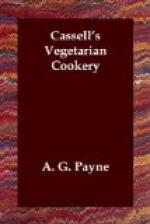CREAMS.—Creams may be divided into two classes—whipped cream, flavoured in a variety of ways, and the solid moulds of cream, which when turned out look extremely elegant, but which when tasted are somewhat disappointing. These latter moulds owe their firmness and consistency to the addition of isinglass, and, as this substance is not allowed in vegetarian cookery, we shall be able to dispense with cream served in this form, nor are we losers by so doing. The ordinary mould of cream is too apt to taste like spongy liver, and, so far as palate is concerned, is incomparably inferior to the more delicate whipped creams. Just in the same way a good rich custard made with yolks of eggs is spoilt by being turned into a solid custard by the addition of gelatine. In order to have good whipped cream, the first essential is to obtain pure cream. This greatly depends upon the neighbourhood in which we live. In country houses, away from large towns, there is as a rule no trouble, whereas in London really good cream can only be obtained with great difficulty. There is a well-known old story of the London milkman telling the cook who complained of the quality of the cream to stir it up, as the cream settled at the bottom. We will not enter into the subject of the adulteration of cream in big cities, as probably many of these stories are gross exaggerations, though it is said that pigs’ brains and even horses’ brains have been used for the purpose of giving the cream a consistency, while undoubtedly turmeric has been used to give it a colour.
We will suppose that we have, say, a quart of really good thick cream. All that is necessary is to beat up the cream with a whisk till it becomes a froth. This is much more easily done in cold weather than in hot, and, if the weather be very warm, it is best to put the tin or pan containing the cream into ice an hour or two before it is used. Old French cookery-books recommend the addition of a little powdered gum, not bigger than a pea, and the gum recommended is that known as tragacanth. Others again beat up the white of an egg to a stiff froth, and add this to the cream. It is a good plan when the cream fails to froth completely to take off the top froth and drain it on a sieve placed upside down. The cream that drains through can be added to what is left and re-whipped. It is also a good plan to make whipped cream some time before it is wanted, and, indeed, it can be prepared with advantage the day before. When the cream is drained (we are supposing a quart to have been used) it should be mixed with three or four ounces of very finely powdered sugar, as well as the particular kind of flavouring that will give the cream its name. For instance, we can have, if liqueurs are allowed—
MARASCHINO CREAM.—This is simply made by mixing a small glass of maraschino with some whipped cream, properly sweetened.
COFFEE CREAM.—Make a very strong infusion of pure coffee that has been roasted a high colour. It will be found best to re-roast coffee berries in the oven if you have not got a proper coffee-roaster. Pound the berries in a pestle and mortar, or grind them very coarsely; then make a strong infusion with a very small quantity of water, and strain it till it is quite bright. This is mixed with the whipped sweetened cream.




